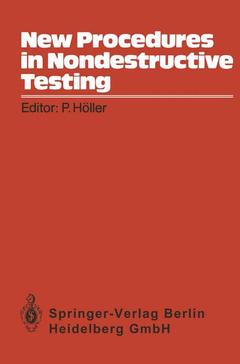New Procedures in Nondestructive Testing, Softcover reprint of the original 1st ed. 1983 Proceedings of the Germany-U.S. Workshop Fraunhofer-Institut, Saarbrücken, Germany, Aug. 30 - Sept. 3, 1982
Langue : Français
Coordonnateur : Höller P.

During recent years an increasing amount of research has been conducted to develop methods and procedures for improving inter pretation in nondestructive testing. This research covers appro priate testing procedures as well as the algorithms for interpre tation. In several cases a state has been reached which allows for implementation. The objective of the workshop was to bring together researchers and industrial users of both countries and colleagues from other countries for a thorough and critical discussion of how far we have come and where we have to go to solve the basic practical problems of interpretation in nondestructive testing and of data acquisition necessary for this purpose. Dr. Dau from EPRI stated during the last International Confer ence for Nondestructive Testing in Nuclear Industry that from the point of view of time and money spent research is the smallest part of innovation but, I would like to add in full agreement with him, the most essential. Without successful research innovation is not possible at all; but neither research and invention nor any other step in an innovation procedure can be left out. Our philosophy is to keep researchers involved until the end of the innovation. That means until a new or improved NOT-method is approved under industrial environment and implemented in industry. There can be no doubt that the further we proceed on this long road the more industry will have to be involved and assume the initiative, responsibility and the leading role.
1. Probes, Data Acquisition and Data Pre-Processing During Ultrasonic Testing.- 1.1 Requirements for the Data Acquisition During Ultrasonic Testing. Search Techniques and Defect Analysis.- 1.2 Hardware-Equipment for Automatic Ultrasonic Inspection by the Alok-Technique.- 1.3 Numerical Filtering of Ultrasonic Backscattered Signals.- 1.4 Logarithmic Analog-To-Digital Conversion — a New Concept for the Processing of Ultrasonic Data.- 1.5 Principles and Practical Applications of Controlled Signals.- 1.6 Ultrasonic Plate Testing with a Freely Programmable Electronic System.- 1.7 Microprocessor Controlled Ut-Equipment.- 1.8 Emus-Probes for Bulk Waves and Rayleigh Waves. Model for Sound Field and Efficiency Calculations.- 1.9 Transient Radiation Pattern of Ultrasonic Transducers On Elastic Half-Spaces.- 2. Classification and Reconstruction of Defects by Ultrasonic Testing.- 2.1 Classification and Reconstruction of Defects by Combined Acoustical Holography and Line-Saft.- 2.2 Pulse-Synthesis and Pulse-Adaptation in Ultrasonic Imaging for Ndt.- 2.3 Acoustic Imaging.- 2.4 Visualization of Ultrasound by Optical Holography.- 2.5 Inspection of Thick-Walled Components by Ultrasonics and Evaluation of the Data by the Alok-Technique.- 2.6 An Ultrasonic Phased Array System for Defect Classification and Reconstruction.- 2.7 Ultrasonic Characterization of Rough Cracks..- 2.8 Surface Cracks: Size and Failure Prediction Using Long Wavelength Measurements.- 2.9 Characterization of Surface Defects by Rayleigh-Waves.- 2.10 Frequency Dependent Interaction of Ultrasonic Waves with Surface-Breaking Cracks.- 2.11 Measurement of Crack Depth with Ultrasonic Methods. Through Transmission- and Reflection Modes.- 2.12 Sizing of Near-Surface Fatigue Cracks in Cladded Pressure Vessels by the Multiple Beam-Satellite Pulse Technique.- 2.13 a Feature Based Ultrasonic System for Reflector Classification.- 3. Forward Scattering.- 3.1 Resonance Scattering Methods for Ndt, Acoustics, and Radar.- 3.2 Scattering of Ultrasonic Waves in Single Phase Polycrystalline Metals Including Multiple Scattering.- 3.3 Results on Broadband Scattering and Diffraction Suggest Methods To Classify and Reconstruct Defects in Qnde.- 3.4 Nde Technique for Detection and Characterization of Porosity.- 3.5 Effects of Mutual Coupling Between Different Points of a Scatterer on Imaging.- 3.6 Forward and Inverse Ultrasonic Scattering Measurements in Realistic Geometries.- 3.7 Bulk Defect Characterization Using Short Wavelength Measurements.- 4.1 Identification and Parametric Modeling of Transient Waves.- 4.2 Ray Methods for Scattering of Ultrasonic Waves by Cracks.- 4.3 Inverse Scattering Algorithms.- 4.4 Exact Direct and Inverse Scattering in Spatial Frequency/Time Space.- 4.5 Application of High Frequency Inverse Scattering To Nondestructive Testing.- 4.6 Extensions of Radon’s Projection Theory in Radar Target Shape Reconstruction.- 4.7 Implementation of Inverse-Scattering Algorithms for Characterizing Voids in Gas Turbine Rotor Discs.- 5. Acoustic Emission.- 5.1 Propagation and Scattering of High-Frequency and Pulsed Signals in the Presence of a Concave Boundary.- 5.2 Transfer-Functions Characterizing the Propagation of Ae-Signals.- 6. Electrical and Magnetical Methods Theory and Applications.- 6.1 Numerical Modeling of Electromagnetic Ndt Phenomena.- 6.2 a Model for the Interpretation of A.C. Magnetic Stray Flux Measurements.- 6.3 Developments and Investigations for the Application of the Pulsed Eddy Current Technique.- 6.4 Analytical Methods in Flaw Response Modeling and Inversion for Ec Testing.- 6.5 Defect Classification by Multi-Multifrequency Eddy Current.- 6.6 Materials Testing by Self-Excited Square-Wave Oscillations with New Lift-Off Compensation.- 7. Nondestructive Stress Measurement.- 7.1 Measurement of Stress.- 7.2 The Use of the Temperature Dependence of Ultrasonic Velocity To Measure Applied and Residual Stresses.- 7.3 Determination of Mechanical Stress by Polarized Shear Waves.- 7.4 Comparison of Different Methods To Determine Residual Stresses Nondestructively.- 7.5 Determination of Residual Stresses Using Micromagnetic Parameters.- 7.6 Measuring of Closure Forces with Ultrasonic Diffracted Waves.- List of Attendees.
Date de parution : 04-2014
Ouvrage de 606 p.
15.5x23.5 cm
Disponible chez l'éditeur (délai d'approvisionnement : 15 jours).
Prix indicatif 105,49 €
Ajouter au panierMots-clés :
© 2024 LAVOISIER S.A.S.



